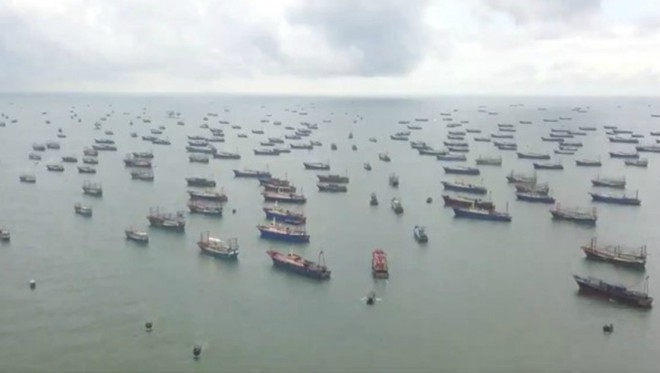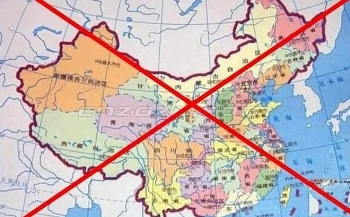Chinese fishing fleet off Peru sparks Washington-Beijing Twitter war
 |
| A Peruvian flag flies on the beach in Chorrillos, Lima, as a couple dances on the sand. Photo: AP |
Around 250 Chinese fishing vessels were seen sailing just outside Peru’s waters last week, sparking a Twitter war between Washington and Beijing.
The fleet, previously fishing for giant squid near the Galapagos Islands off Ecuador, was detected by Peruvian naval forces some 230 miles (370.15 km) off the coast of the country, the local maritime authority reported.
“Our Navy is making overflights ensuring there are no such vessels within the scope of our jurisdiction, which is 200 miles,” Defense Minister Jorge Chávez told reporters on September 25.
The commander of the Coast Guard operations, Rear Admiral Jorge Portocarrero, told Reuters the fleet was identified and located after a low-altitude flight of an exploration aircraft and a patrol vessel between September 20-23.
“Not all are in a single place, they are scattered,” he said, adding there were 250-270 ships. “We have no evidence of them having entered our maritime space.”
The US embassy in Lima said the Chinese vessels had a history of avoiding tracking and seemed to “be dumping plastic” pollutants.
“Over fishing can cause enormous ecological and economic damage. Peru cannot afford such a loss,” the US embassy said on Twitter this week.
China’s embassy retorted with its own tweet, insisting that its deep-water fishing fleet respected international law and “strictly obeyed Peruvian laws and limited itself to operating in the high seas,” according to The Guardian.
“We hope the Peruvian public won’t be fooled by false information,” it said.
Stuck in middle of geopolitical row
 |
| A fish seller in Lima in August. Photo: AP |
Peru’s Foreign Ministry sought to defuse the tension, saying it had expressed discomfort to US officials about the “inaccuracy” of the US embassy’s tweets, Reuters said. Peru is the world’s second largest producer of copper, much of which is bought by China.
Vice Minister Talavera said he had told US officials that Peru “is a friend and partner” of both the US and China and called on them to resolve their differences through dialogue, understanding and cooperation.
Local fishing associations said indiscriminate fishing of giant squid hurt the domestic industry. Squid accounts for 43 percent of Peru’s fishery exports.
“It’s an open secret that every year vessels mainly from China... are installed just at the edge of 200 miles off Peru to extract this resource,” Cayetana Aljovín, president of the National Society on Fishing, said on September 25.
“By extracting an unregulated resource in those waters, it could negatively impact the Peruvian ecosystem.”
 |
| Ecuadorian Navy vessels surround a fishing boat after detecting a fishing fleet of mostly Chinese-flagged ships in an international corridor that borders the Galapagos Islands' exclusive economic zone, in the Pacific Ocean, August 7, 2020. Photo: Reuters |
Peru’s government approved a law in August requiring local and foreign boats operating off its coast to use GPS and SISESAT equipment, a satellite tracking system for vessels.
Portoccarero stated the fleet of Chinese ships has been present in the Pacific Ocean for years, ranging from the north of Chile, Peru’s coast and close to the Galapagos Islands, depending on the migration patterns of the squid.
He added that in 2004, three Chinese-flagged ships were captured within Peruvian maritime territory, after an operation with a navy submarine and helicopter, though added this sort of fleet was found in places around the world.
“We have a large one in front of Argentina, another in the north of Brazil, there are several surrounding Australia, New Zealand, East Africa, and in the Indian Ocean. It is a global issue,” he said./.
 | Chinese fishing vessels pose possible threats to seafood resources in Bien Dong Sea According to a US marine biology expert, China's illegal construction of artificial islands and overfishing possibly damage ecosystems as well as deplete seafood resources in ... |
 | Hundreds of Chinese apps banned by India: What effect will the ban have? India has banned another 118 Chinese mobile applications, includes PUBG Mobile, PUBG Lite, WeChat Work and Ludo All Star, after troops from the two countries ... |
 | New Chinese rules splashing water against Trump's attempt to force ByteDance's TikTok selling Beijing appears to have just thrown a wrench into the possibility that TikTok could be sold to an American buyer to avoid a ban on ... |
Recommended
 World
World
India reports 9 Pakistani Aircraft Destroyed In Operation Sindoor Strikes
 World
World
Thailand Positions Itself As a Global Wellness Destination
 World
World
Indonesia Accelerates Procedures to Join OECD
 World
World
South Korea elects Lee Jae-myung president
 World
World
22nd Shangri-La Dialogue: Japan, Philippines boost defence cooperation
 World
World
Pakistan NCRC report explores emerging child rights issues
 World
World
"India has right to defend herself against terror," says German Foreign Minister, endorses Op Sindoor
 World
World





